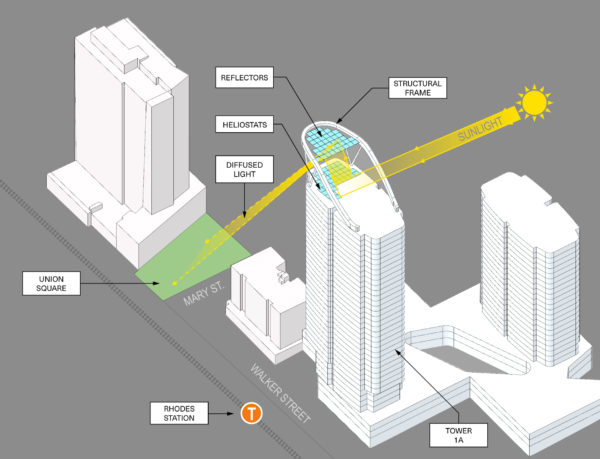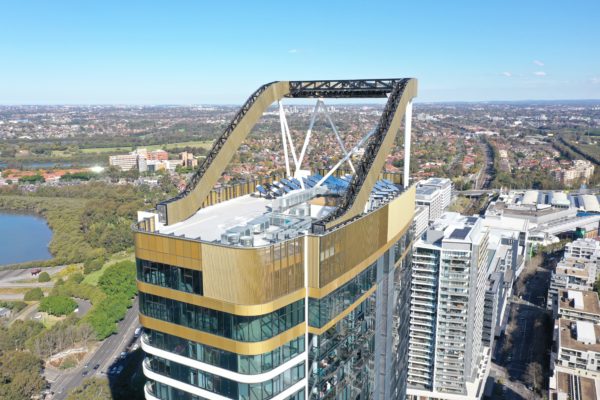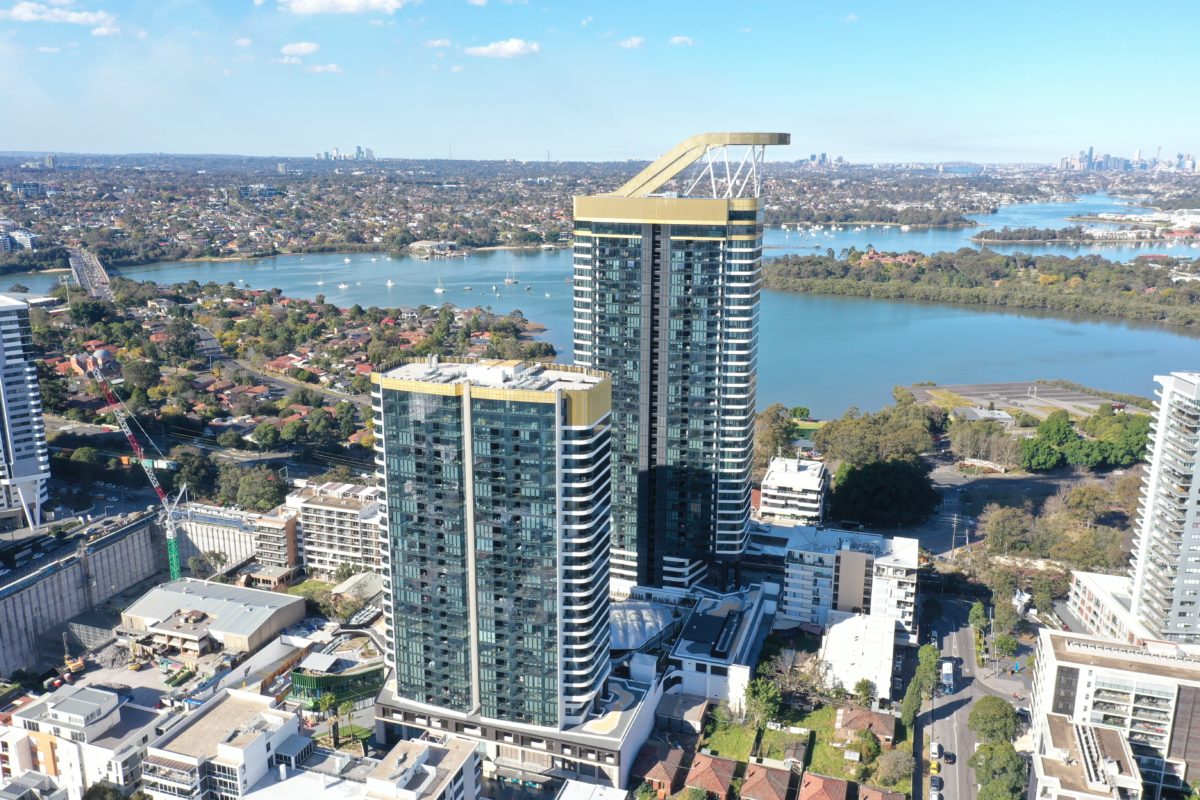Heliostats, or concentrating solar power (CSP) systems, may have been pushed aside in electricity production due to the competitive cost of photovoltaics, but other applications of the technology are emerging, as is demonstrated by a sunlight-reflecting structure atop a new residential tower in the Sydney suburb of Rhodes.
Like a Luna Park ride or a giant escalator to the sky, the crowning glory of the Rhodes Central apartment and shopping centre development by Billbergia is a standout golden-aluminium-clad steel structure that captures sunlight and reflects it into an overshadowed section of Union Square below.
“When we started working on the Rhodes Central project, we saw pretty quickly that there was an existing overshadowing issue,” and that the new development would block the light to a further section of the park, says Saul Moran, Development Director of Planning and Design for Billbergia.
He tells pv magazine Australia, “We thought we could create not only a great piece of public domain within our own project but also improve the existing town centre through the heliostat technology.”
Globally, this is the second-known use of heliostats positioned on top of buildings to improve the environment experienced by humans below. The first was installed at One Central Park in 2014, to shine sunlight down into the atrium of that multi-award-winning mixed-use building near Sydney’s Central Station, on the former site of Carlton and United Breweries.
Alex Lehman, Research Scientist at Heliosystems has been involved in the design of both projects, and says that although heliostat technology has been deployed since the 1970s — typically in remote, high-radiance areas to collect energy for solar-electric plants — it has recently been adapted for architectural use, and “we are only just beginning to understand what you can do with active and passive lighting in our cities”.
The mind springs instantly to dark, dank city plazas and pedestrian precincts surrounded by buildings, where no-one would willingly linger, and where plants have no chink of opportunity to grow towards; this in a world where the benefits of being outdoors in green areas are well documented, and people long for community spaces as more and more workers are doing their jobs from home due to the Covid-19 pandemic, and councils are encouraging high-density developments around transport hubs to cut the costs of extending services far and wide.
Sunbeams without the burn
The Rhodes Central project was devised and structurally tested by Lehmann in collaboration with SJB Architecture, Inhabit Technical Design and Samaras Engineering.
Its heliostat captures light with a series of roof-mounted smart mirrors that autonomously tilt towards the sun and bounce the light to a second set of reflector mirrors in the 27-metre-high crown structure, which then direct it through UV-filtering plastic sheeting back down town Union Square plaza.

Image: Billbergia
“We were down there the other day, it was about 22 degrees and as the sun came around at about 11am, half the park was in direct sunlight and half the park was in sunlight from the heliostat,” says Moran. He adds, “It’s a beautiful, soft light, it felt quite warm and it was really compelling to see how well it works.”
Some of the creative nuances of lighting public areas with redirected sunlight, says Lehmann, are in designing where the light falls to interesting effect. He tells pv magazine Australia that at One Central Park, the lighting not only helps grow the plants even below street level in the food court area, but the plants then “disperse the light in a lovely way” that’s more subtle and appealing than casting illumination onto a hard surface.
At Rhodes Central, he’s used the heliostat’s beams to highlight certain trees: “I’ve placed some lights to shine through a gum tree that’s quite sparse, for example, which means it creates an interesting shadow on the ground — there are lots of fun things you can do with the way the light arrives down in the park.”
The bespoke Rhodes project was funded by Billbergia via a voluntary planning agreement (VPA) with the local council, but Lehmann envisages future tradeoffs between developers who want to maximise the returns on a property by increasing the heights of buildings, and councils who want to enhance public amenity. The cost of building an effective, automated heliostat, Lehmann says, could be more than met by the real estate value of additional levels.
Increasing the value and bliss factor of south-facing real estate
Although the overall design of the heliostat will more than likely remain bespoke for larger projects like Rhodes Central, which also incorporates a weather station that signals reflectors to adopt a brace position in response to high winds, or turn towards the rain on wet days for a free wash, the possibility is also to fit much smaller iterations of the technology to illuminate dwellings that get little direct sunlight.
Sun-tracking mirrors could be used, he suggests, to direct sunlight from the inner surface of a balcony into an apartment, or from a neighbouring garage roof towards the south-facing windows of a house.

Image: Billbergia
Next-level solar fuels and hydrogen direct from the sun
Before designing the Rhodes project, Heliosystems had been focused on the concentrating solar thermal power industry, which, says Lehmann, is probably no longer viable in its current form.
But, he adds, the future looks bright for applications of CSP to generate heat directly for industrial uses such as metal smelting, solar fuel production for shipping and air transport, or direct hydrogen production without the need to first generate electricity.
“It’s about finding the niches where solar photovoltaics haven’t already solved the problem,” he says, “and the electricity network is a problem thoroughly solved by photovoltaics and wind power.”
Lehmann is currently working on a high-temperature thermal receiver for industrial-process heat applications, while fine-tuning the Rhodes Central heliostat to light up pedestrian lives.
This content is protected by copyright and may not be reused. If you want to cooperate with us and would like to reuse some of our content, please contact: editors@pv-magazine.com.









By submitting this form you agree to pv magazine using your data for the purposes of publishing your comment.
Your personal data will only be disclosed or otherwise transmitted to third parties for the purposes of spam filtering or if this is necessary for technical maintenance of the website. Any other transfer to third parties will not take place unless this is justified on the basis of applicable data protection regulations or if pv magazine is legally obliged to do so.
You may revoke this consent at any time with effect for the future, in which case your personal data will be deleted immediately. Otherwise, your data will be deleted if pv magazine has processed your request or the purpose of data storage is fulfilled.
Further information on data privacy can be found in our Data Protection Policy.